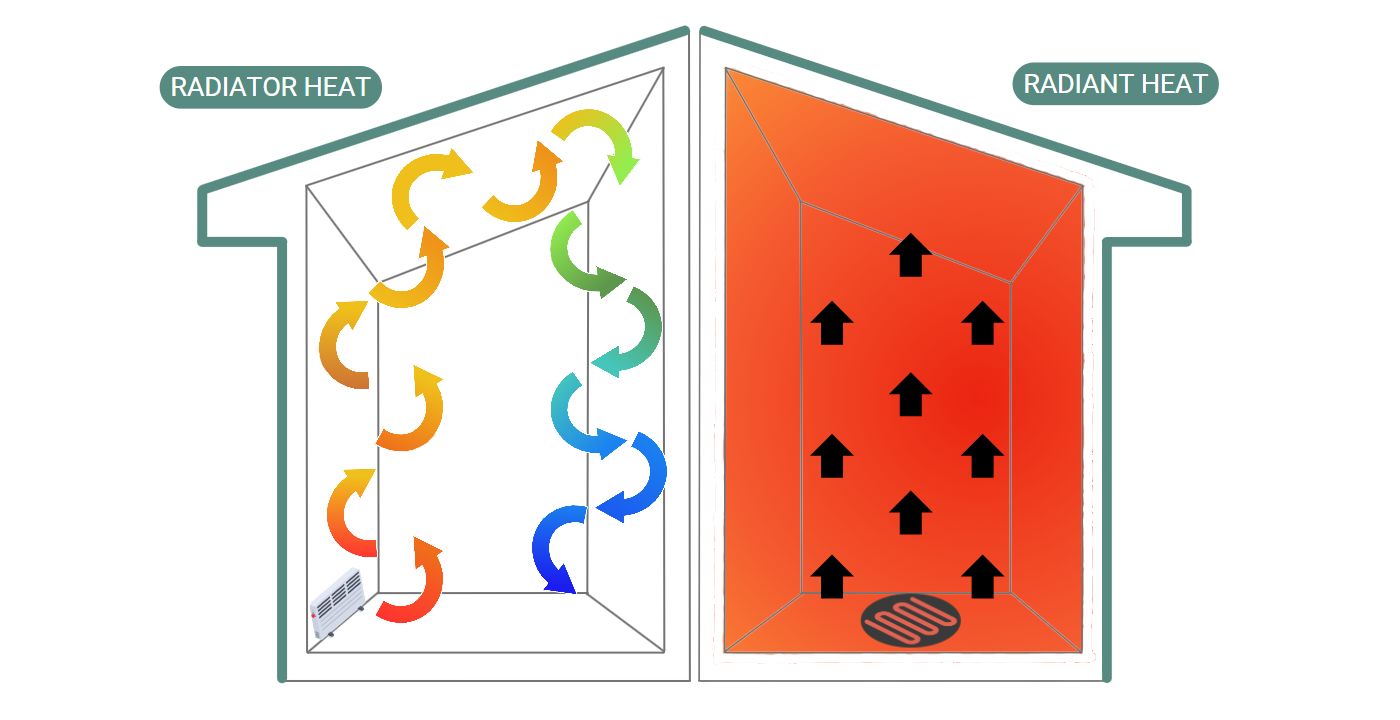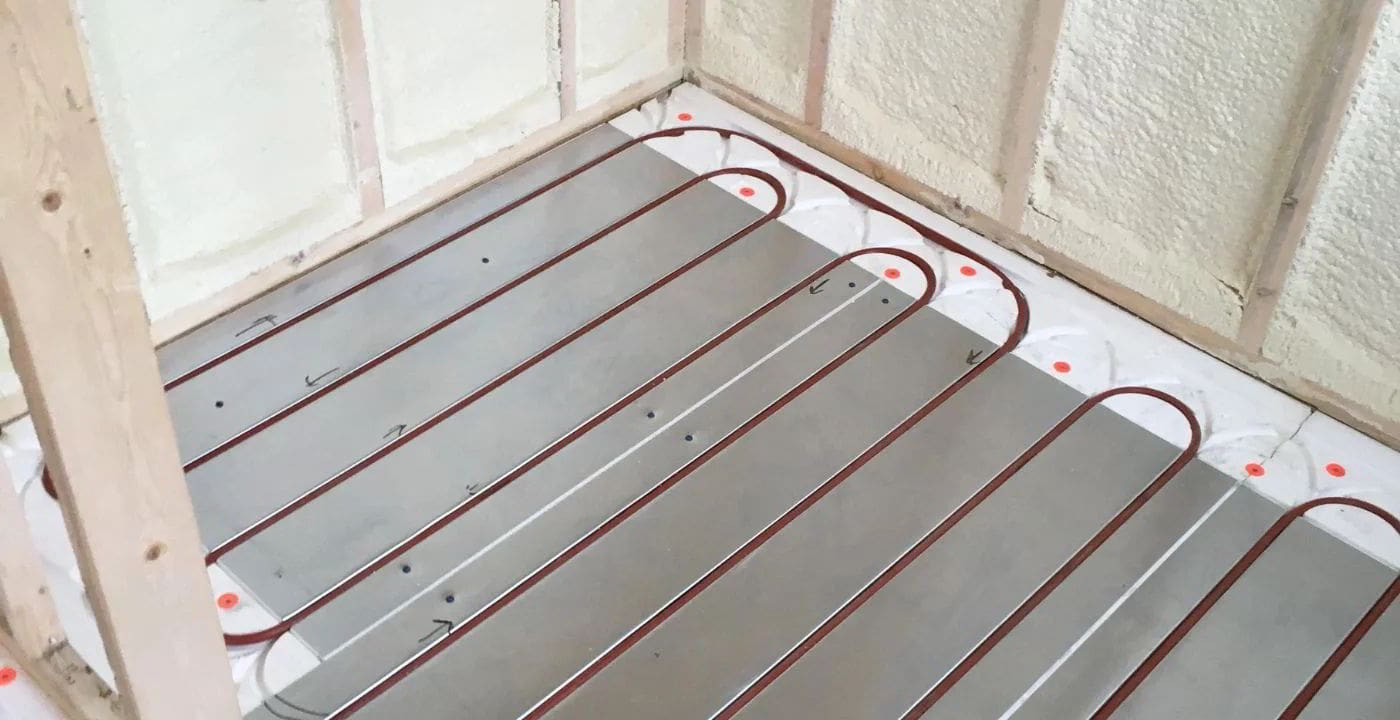Key Takeaways
- Retrofitting radiant floor heating is feasible, efficient, and a luxurious addition to any renovation project.
- There’s no strict need to rip up your existing floor in most retrofit projects.
- Retrofit radiant floor heating can be applied to various home areas, including 1st floor, upstairs bedrooms and bathrooms, and basements.
Can you retrofit radiant floor heating?
Yes, retrofitting underfloor heating into your home is not just possible, but also increasingly popular. Renovating a house doesn’t present the blank canvas that a new build does, yet modern retrofit radiant floor heating systems are designed to integrate seamlessly.
With advancements in technology, solutions are available to overcome architectural challenges, ensuring a warm and comfortable home regardless of its age or design.
The beauty of electric radiant heating is its flexibility. If there’s access to floor joists from below, such as in unfinished basements, adding radiant heating is straightforward without the need to alter the flooring above.
Even with finished ceilings or floors, the process is as simple as removing the ceiling drywall, installing the heating system, and then replacing the drywall. Your pristine floors remain untouched.
Is it a good idea to retrofit radiant floor heating?

Absolutely. While the process of retrofitting is inherently more complex than installations in new constructions, it’s less daunting and more affordable than many homeowners imagine.
The efficiency and luxury of underfloor heating retrofit can elevate the living experience.
Moreover, in most retrofit projects, homeowners won’t need to tear up the existing floor completely, making it a more accessible choice for many.
How does retrofit radiant floor heating work?
 Electric radiant heating mats, thin and efficient, are stapled to the subfloor between the joists and beneath the finished flooring.
Electric radiant heating mats, thin and efficient, are stapled to the subfloor between the joists and beneath the finished flooring.
The heat radiates upwards, seamlessly transitioning through the subfloor and the flooring above. This ensures warmth and comfort throughout the year without any major alterations to your current flooring.
The general process is as follows:
- Count the number of joist bays
- Measure the width and length of the joist bays.
- Design the system/layout based on the results
- Cut the heating elements to the desired length
- Secure them with staples to the underside of the joists
- Connect the heating element to the transformer with appropriate wiring
- Add the insulation (usually batt or rigid foam)
What areas of the house can be retrofitted with radiant floor heating?
- 1st Floor Living Spaces: The primary areas of the home where families spend most of their time.
- Upstairs Bedrooms and Bathrooms: Ensuring a cozy wakeup and a warm step post-shower.
- Basements: Often the coldest part of a home can be transformed into a warm living or recreational space.
Installing retrofit floor heating

1st floor living spaces radiant heat retrofit
What to consider
Evaluate the floor joists’ accessibility, either from basements or crawl spaces.
Ensure compatibility with your chosen flooring type, and ascertain insulation requirements for optimal heat direction.
Installation
Begin by precisely measuring the required area. Once done, cut the radiant heating mats accordingly.
These mats then need to be fastened using staples to the subfloor, resting snugly between the joists.
Wiring is the subsequent step, where each heating element is connected with a pair of wires that merge with the transformer.
After ensuring all connections are secure, insulation comes into play. Use either batt or rigid foam insulation behind the heating elements, ensuring an upward trajectory of heat.
Materials
Thin electric heating mats, transformers, and insulation materials like batt or rigid foam.
Costs
Expect an average spend between $7.90 to $15.00 per ft², amounting to approximately $790 – $1,500 for a 100 ft² area.
If you would like further information on the costs of radiant floor heating take a look at our blog How Much Does Radiant Floor Heating Cost?
Top tips
- Before installation, liaise with professionals to understand any nuances specific to your home structure.
- Ensure the insulation is correctly placed for maximum heat efficiency.
Bedrooms and bathrooms (2nd floor) radiant heat retrofit
What to consider
Before initiating the retrofit process in bedrooms and bathrooms, ensure you can access the floor joists.
Unlike the 1st floor, these rooms might not have the advantage of an unfinished basement below.
You may find finished ceilings that could necessitate some drywall adjustments.
When retrofitting the 2nd floor, especially the bedrooms and bathrooms, factor in the type of flooring.
Bathrooms often have moisture-resistant flooring, and bedrooms may have carpet or hardwood.
Ensure the radiant heating system is compatible with these different floor types.
Installation
Start by precisely mapping out the area that requires heating. Based on this, trim the radiant heating mats to fit these specifications.
Next, securely fasten these mats to the subfloor using staples, ensuring they’re situated between the joists for maximum effectiveness.
Always use a qualified electrician for any electrical work required in a retrofit renovation project.
The next stage involves wiring: each heating element should be connected with a pair of wires that subsequently link to the transformer.
After ensuring all connections are in place and functioning correctly, it’s time for insulation.
Depending on the specific needs of the bedroom or bathroom, choose either batt or rigid foam insulation.
This insulation should be positioned behind the heating elements, which guarantees that the heat is directed upwards, ensuring a cozy environment.
If you plan on using foil insulation with electric radiant heat you must ensure there is a barrier between the insulation and the heating element
Materials
Similar to the first floor, you’ll need heating mats, transformers, and insulation.
Costs
The costs remain the same as with first floor retrofits with the budget ranging between $7.90 to $14.00 per ft².
Top tips
- Ensure that the radiant heating system doesn’t interfere with any plumbing lines, particularly in bathrooms.
- Be extra cautious with bathroom installations because of the high moisture content. Seal connections well to avoid any potential hazards.
- Always test the system before sealing up any accessed areas to ensure everything is working as expected.
Basement radiant heat retrofit
What to consider
Basements inherently feel colder. Ensuring that the retrofit covers the entirety of the space will ensure uniform warmth.
When embedding radiant heating in a concrete slab, it’s essential to acknowledge that concrete is an excellent conductor of heat, making it an efficient choice for this type of heating.
However, moisture issues and the quality of the slab are factors to consider before installation.
Installation
- Installation in basement flooring is the same unless you are dealing with concrete slab, for which you should proceed as follows.
- Ensure that the concrete slab is clean and free of any debris (it’s advisable to install a vapor barrier if there are any moisture concerns to prevent potential damage to the heating elements).
- Lay out the electric radiant heating mats or cables according to the design specifications.
- Once the heating system is spread out evenly, check for any overlaps or twists (as these can cause hotspots or malfunction).
- When you’re satisfied with the placement, connect the system to the thermostat and perform a resistance test to ensure all components are working correctly.
- Encase the heating system in concrete – pour a layer of self-leveling underlayment or a fresh concrete layer over the heating system to embed the radiant heating mats or cables within the slab.
- Check to ensure the heating system is fully covered and protected by the concrete.
- Allow the concrete to cure according to the manufacturer’s recommended time, usually a few days to a week, before turning on the radiant heating system (this will prevent any premature damage to the heating elements).
Materials
Same Materials as above.
Cost
$7.9 to $14.00 per ft².
Top Tips
- Consider embedding the heating elements directly into the concrete slab for efficient heating in basements.
- Always double-check for water leaks or moisture issues in the basement before installation to ensure the longevity and safety of the system.
- If your basement is prone to flooding, have safeguards in place like a sump pump to avoid damages to the radiant heating system.
- For basements with high humidity, consider using a dehumidifier alongside the radiant heating to maintain a comfortable environment.
FAQs
How to insulate your retrofit underfloor heating
For optimal heat direction, employ either batt or dense foam insulation behind the heating mats. This ensures the heat is channeled upwards, creating an ambient atmosphere.
What's the average lifespan of electric radiant floor heating systems?
Typically, with proper installation and maintenance, these systems can last several decades, offering consistent performance for half a lifetime or more.
How energy-efficient are these systems compared to traditional heating?
Electric radiant floor heating systems are highly efficient, especially those operating on 24V ESLV.
Their broader coverage area ensures less energy consumption while delivering heightened comfort.
Can I adjust the heating as per different zones in my house?
Yes, many modern electric radiant floor heating systems come with zonal control, allowing you to manage temperatures based on individual room or area needs
Conclusion
Choosing to retrofit underfloor heating is a game-changer for home renovation projects. It combines the luxury of warmth with the efficiency of modern technology.
Whether looking to upgrade a basement, bedroom, or living space, electric radiant floor heating is an investment in unparalleled comfort that you will enjoy for decades.
If you’re considering an underfloor heating retrofit and would like to have a conversation about what it would involve please get in touch.





